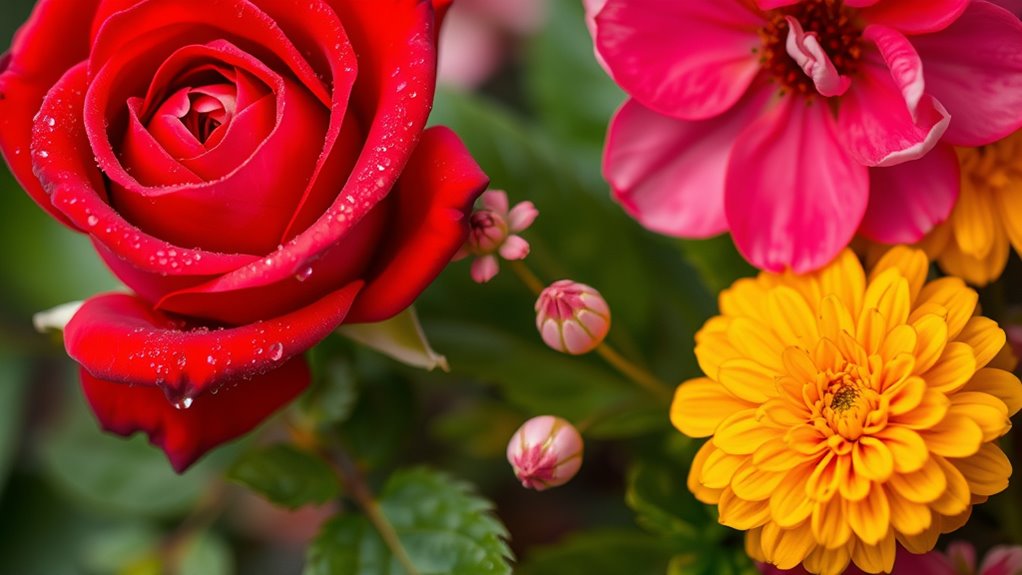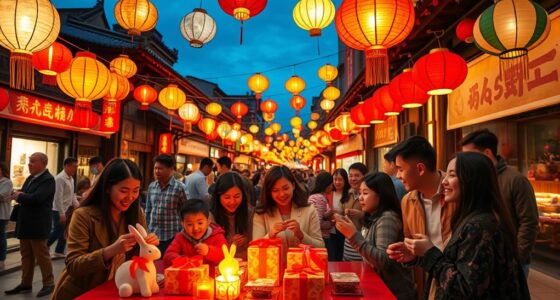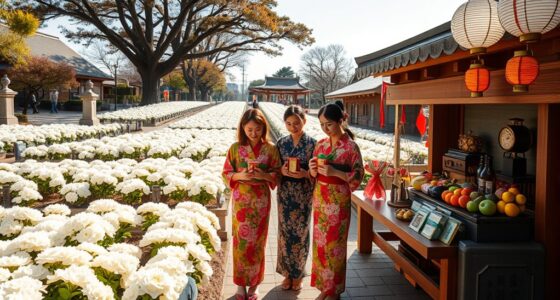Flowers symbolize a wide range of emotions and beliefs across cultures. For example, cherry blossoms in Japan reflect life’s fleeting beauty, while roses convey love in Western traditions. Lotus flowers symbolize purity and spiritual growth in Asia, and marigolds honor ancestors during Mexican celebrations. Each flower’s color also deepens its meaning, like red for passion or white for purity. To explore how these symbols connect to cultural stories and traditions, keep exploring further.
Key Takeaways
- Flowers serve as symbols of cultural values, spiritual beliefs, and social customs across diverse societies.
- Specific flowers like cherry blossoms, marigolds, lotus, protea, and roses hold unique cultural and spiritual meanings.
- Flower colors convey emotional messages, such as red for love, white for purity, and pink for admiration.
- Flowers are integral in rituals, festivals, and ceremonies, representing themes like life, death, resilience, and enlightenment.
- Floral symbolism helps preserve cultural heritage and enhances emotional expression through art, poetry, and tradition.
The Cultural Significance of Cherry Blossoms in Japan

Cherry blossoms, or sakura, hold a special place in Japanese culture because they symbolize the fleeting nature of life and beauty. During cherry blossom festivals, you’ll witness locals and visitors gathering beneath blooming trees, celebrating renewal and the transient moments of life. These festivals are more than just viewing parties; they embody Japanese floral symbolism, reminding everyone to cherish each moment. The delicate pink petals serve as a visual metaphor for impermanence, encouraging reflection on life’s delicate balance. As you experience these festivals, you’ll notice how deeply rooted sakura is in Japanese traditions, inspiring art, poetry, and social customs. The fleeting bloom reminds you to appreciate beauty and live fully in the present, embracing life’s ephemeral nature. Additionally, the cultural significance of cherry blossoms is reinforced through flower symbolism, which plays a vital role in shaping Japanese aesthetic values and philosophies. Recognizing the contrast between transient beauty and enduring cultural practices further enriches your understanding of their symbolic importance. This ongoing appreciation for natural beauty and cultural heritage highlights how flowers can serve as powerful symbols across different societies. In Japan, cherry blossoms are also associated with renewal and hope, emphasizing their role in inspiring optimism during seasonal changes.
Roses and Their Romantic Connotations Across the West

Roses are widely recognized as symbols of love in Western cultures, often given to express romantic feelings. Their different colors carry specific meanings—red for deep passion, pink for admiration, and white for purity. These variations enhance the message you convey when choosing a rose for someone special. Incorporating color symbolism can deepen the emotional impact of your gesture. Additionally, understanding the cultural significance of flowers can help you select the most appropriate flower for the occasion. Recognizing the history of floral symbolism across different societies further enriches your appreciation of this universal gesture. Moreover, engaging in consistent creative practice can help you better understand and express complex ideas through symbols like flowers, enriching your cultural insights.
Symbol of Love
Throughout Western history, flowers have served as powerful symbols of love, with the rose standing out as the most iconic. Its flower symbolism communicates deep affection and passion, making it a popular gift for romantic occasions. In cultural expressions, giving a rose often signifies desire, admiration, or devotion. The tradition of presenting roses dates back centuries, reinforcing their role as expressions of love across different eras. Red roses, in particular, symbolize passionate love, while other varieties can convey friendship or admiration. You can see how this flower’s symbolism has become ingrained in Western customs, shaping romantic gestures and celebrations. By choosing roses, you tap into a universal language that transcends words, expressing complex emotions through a simple, yet powerful floral gesture. The cultural significance of flowers continues to evolve, influencing modern expressions of love worldwide.
Variations in Color
In Western cultures, the color of a rose substantially influences its romantic meaning, allowing you to convey specific feelings through color variations. For example, red roses symbolize love and passion, while pink roses represent admiration and gratitude. White roses often signify purity and innocence, and yellow roses express friendship or joy. Understanding flower symbolism helps you select the perfect rose for every occasion. Here’s a quick overview:
| Color | Flower Symbolism | Romantic Connotation |
|---|---|---|
| Red | Love, passion | Deep romantic interest |
| Pink | Admiration, gratitude | Gentle affection |
| White | Purity, innocence | Respect, new beginnings |
Color variations allow you to communicate nuanced emotions, making roses a versatile symbol of romance. Flower symbolism plays a significant role in cultural expressions of emotion and tradition. Recognizing these color meanings can aid in selecting the appropriate flower for meaningful events. Additionally, honey’s natural benefits are often associated with purity and wellness, paralleling the symbolism of white roses in conveying innocence and health.
Lotus Flowers in Asian Spiritual Traditions

Have you ever wondered why the lotus flower holds such profound significance in Asian spiritual traditions? It’s because the lotus symbolizes purity, enlightenment, and rebirth. In meditative practices, practitioners often focus on the lotus to represent spiritual growth rising above worldly impurities. The flower’s ability to bloom beautifully from muddy waters reflects spiritual awakening amid challenges. In cultures like Buddhism and Hinduism, the lotus is a powerful symbol of spiritual symbolism, embodying the journey toward enlightenment and inner peace. Its steady rise from darkness to light inspires devotion and mindfulness. You’ll find lotus imagery in temples, art, and rituals, reminding you of the importance of purity and transcendence on your spiritual path. Additionally, the symbolic meaning of flowers in various cultures further emphasizes the universal importance of floral symbolism in human spirituality. Understanding the nutrients retained in cold-pressed juices can also inspire a holistic approach to health and spiritual well-being, highlighting the connection between inner and outer harmony. Recognizing the cultural significance of flowers across different regions deepens the appreciation of their role as enduring symbols of resilience and hope. The enduring presence of the lotus across centuries underscores its significance as a cultural and spiritual emblem of resilience and hope.
Marigolds and Their Role in Mexican Celebrations

Marigolds are essential in Mexican celebrations like Día de los Muertos, where they symbolize the connection between the living and the dead. You’ll find these vibrant flowers used to decorate altars and graves, reflecting their deep cultural significance. Their bright color and strong scent are believed to guide spirits back to the world of the living. Additionally, the odor control features of some floral arrangements help maintain the freshness and symbolism of the flowers during these festivities. The symbolic meaning of marigolds enhances their role in honoring ancestors and celebrating life and death. Understanding the self watering plant pots can also help preserve flowers like marigolds for extended displays, ensuring their beauty and significance last throughout the celebrations. Proper screening guidelines are important for early detection of breast cancer, which underscores the importance of cultural symbols like marigolds in commemorating life and health. Innovations in automation in business can also support the production and distribution of preserved flowers for such events.
Marigolds in Dia De Los Muertos
During Dia De Los Muertos, marigolds play an essential role in honoring the deceased, as their vibrant orange and yellow hues symbolize the sun’s energy and guide spirits back to the world of the living. You’ll notice marigolds in dia de los muertos used prominently in floral offerings, where they create a vivid path leading to altars. These flowers are believed to attract and guide wandering spirits with their bright color and strong scent. When you prepare a floral offering, including marigolds, you help guarantee that the spirits can find their way home. Their presence transforms gravesites and altars into lively, colorful displays of remembrance. Marigolds serve as a powerful symbol of life, death, and the enduring connection between the living and the departed. Understanding the symbolism of flowers enhances appreciation of their cultural significance during these celebrations. Additionally, the cultural significance of flowers in various traditions reflects their deep-rooted symbolism across different societies.
Symbolic Meanings of Marigolds
Marigolds, with their vivid orange and yellow petals, carry deep symbolic meanings in Mexican culture, especially during celebrations like Dia De Los Muertos. They represent the sun’s energy, guiding spirits back to the living world. Beyond their floral symbolism, marigolds have medicinal uses, traditionally used to treat ailments like skin infections and fevers. Their bright colors evoke warmth and remembrance, reinforcing their role as symbols of life and death. You might notice their scent and appearance are believed to attract spirits and ward off negative energies. This dual significance—both practical and symbolic—makes marigolds integral to Mexican traditions. Their vibrant presence honors ancestors, keeping their memory alive while also serving medicinal purposes rooted in cultural history.
Cultural Significance and Traditions
In Mexican celebrations like Dia De Los Muertos, marigolds play an essential role in honoring ancestors and guiding spirits back to the living world. Their vibrant color and strong scent are rooted in botanical symbolism, representing life, death, and remembrance. These flowers are central to cultural floral practices, often used to decorate altars and graves. You’ll notice that marigolds are believed to attract spirits, making them a crucial part of traditional rituals. Their significance goes beyond aesthetics, embodying respect and connection with loved ones who have passed. By incorporating marigolds into these customs, communities preserve their cultural heritage and reinforce the spiritual bond between the living and the dead. This tradition highlights the deep-rooted importance of flowers in expressing collective beliefs and cultural identity.
The Meaning of Protea in African Cultures

The protea holds a special place in many African cultures, symbolizing resilience, transformation, and strength. As a prominent part of African floral symbolism, it reflects the ability to endure hardships and adapt through change. When you see a protea, you’re witnessing a symbol of perseverance and beauty against adversity. Its significance extends beyond beauty, representing hope and renewal for communities. The proteas as symbols of resilience inspire individuals to stay strong despite challenges. In African traditions, they also embody the cycle of life and growth. This flower’s unique appearance makes it a powerful emblem of transformation and endurance. Its cultural importance emphasizes that resilience and strength can flourish even in tough environments, making the protea a profound symbol in African heritage.
Iris as a Symbol of Wisdom and Valor in Greece

In Greek culture, the iris is celebrated as a powerful symbol of wisdom and valor, embodying qualities highly valued by ancient societies. Its significance stems from ancient Greek symbolism, where the flower represented the connection between heaven and earth. Mythological representations link the iris to Iris, the messenger goddess who served as a bridge between gods and humans, symbolizing communication, knowledge, and courage. The flower’s vibrant colors and elegant form further emphasize its association with bravery and insight. In Greek art and literature, the iris often appears as a motif of heroic qualities and divine inspiration. By understanding its mythological roots, you see how the iris embodies the virtues of wisdom and valor, making it a cherished symbol in Greek cultural heritage.
The Poppy’s Connection to Remembrance and War Memorials

Just as the iris symbolizes valor and wisdom in Greek culture, the vibrant red poppy has come to represent remembrance and respect for those who served in wartime. You’ll notice its significance in memorials, especially on Remembrance Day. The poppy’s role extends beyond tradition; it’s a powerful symbol in modern art, often used to evoke emotion and reflection. Its bold color makes it a favorite in contemporary activism, raising awareness for veterans and peace initiatives.
- Featured in poignant memorial displays
- Used in modern art for emotional impact
- Symbolizes hope and sacrifice in activism
- Reminds us of the ongoing importance of remembrance
Tulips and Their Historical Importance in the Ottoman Empire

During the height of the Ottoman Empire, tulips became more than just beautiful flowers—they symbolized wealth, power, and cultural sophistication. This period, known for its exquisite Ottoman empire horticulture, saw tulips flourish as a status symbol among the elite. The famous Tulip mania history highlights how these flowers sparked intense passion and economic activity, with wealthy patrons cultivating rare varieties. Tulips were carefully bred and displayed to demonstrate prestige, often reflecting the empire’s artistic and cultural achievements. Their significance extended beyond aesthetics, representing prosperity and refinement. You can see how tulips became woven into Ottoman identity, influencing art, poetry, and social customs, transforming from simple garden plants into symbols of opulence and cultural excellence.
The Use of Lavender in European Healing and Rituals

Lavender has long been valued across Europe for its soothing properties and spiritual significance, playing a vital role in healing practices and rituals. Medicinal lavender was often used to cleanse spaces, promote relaxation, and ward off negative energies. In European rituals, it symbolized purity, calmness, and protection. You might have encountered it in traditional herbal remedies or as part of spiritual cleansing ceremonies. Its fragrant aroma helped create a tranquil atmosphere during healing sessions. Lavender was also burned or included in sachets to guarantee restful sleep and mental clarity. Its versatility made it a staple in both everyday wellness routines and sacred rituals. Whether in medicinal or ritual contexts, lavender’s presence highlights its enduring importance in European cultural practices.
Frequently Asked Questions
How Do Flower Meanings Vary Within Different Regions of the Same Country?
You might notice that flower meanings change within different regions of the same country because of regional floral customs and local plant symbolism. Each area often has unique traditions, so a flower representing love in one place could symbolize mourning elsewhere. These regional differences reflect local history, beliefs, and environment, making flower meanings diverse even within a single country. Paying attention to local customs helps you understand the true significance of flowers in each region.
Are There Universal Flower Symbols Recognized Globally Across All Cultures?
You might wonder if there are universal flower meanings recognized across all cultures. While some flowers, like the white lily or red rose, carry cross-cultural symbolism, many floral meanings vary profoundly. It’s essential to understand that universal flower meanings are limited, and cultural context often influences symbolism. So, don’t assume that a flower’s meaning is the same everywhere; explore specific cultural interpretations for accurate understanding.
How Do Historical Events Influence Flower Symbolism in Various Societies?
Did you know that over 80% of global flower symbolism traces back to historical events? You can see how trade routes like the Silk Road spread flower meanings, while colonial influences introduced new symbols. These events shape how societies interpret flowers, blending native traditions with foreign ideas. As a result, flower symbolism evolves, reflecting historical connections and cultural exchanges that continue to influence your understanding today.
What Role Do Flowers Play in Modern Cultural Rituals and Celebrations?
You see flowers playing a central role in modern cultural rituals and celebrations. During flower festivals, you’re immersed in vibrant displays that honor nature and community spirit. In wedding traditions, flowers symbolize love and new beginnings, adding beauty and meaning to the event. These practices connect you to cultural heritage, enriching your experience and emphasizing the timeless significance of flowers in celebrations worldwide.
Can Flowers Convey Messages Beyond Traditional Cultural Interpretations?
You can definitely use flower language to convey messages beyond traditional meanings. Flowers serve as a powerful form of emotional expression, allowing you to communicate feelings that words might not capture. By choosing specific blooms, you send subtle messages to others, whether it’s love, sympathy, or congratulations. This modern use of flowers expands their role, making them a versatile tool for personal expression in various contexts, from gifts to gestures.
Conclusion
Flowers are like universal storytellers, whispering centuries of meaning across cultures. Whether you see cherry blossoms blooming softly in Japan or marigolds brightening Mexican festivities, each petal carries a message. By understanding these symbols, you unseal a garden of shared human experience. So, next time you see a flower, remember—you’re holding a piece of someone’s history, a delicate yet powerful bridge connecting hearts worldwide.









